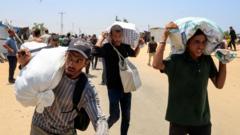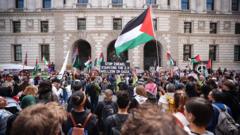Did Local Gunmen and Israeli Forces Clash Near Gaza Aid Site?

Understanding the Humanitarian Crisis in Gaza: Aid Distribution Amidst Violence
The ongoing humanitarian crisis in Gaza has escalated dramatically over recent months, with the conflict intensifying and affecting the lives of millions. As aid distribution efforts struggle to meet the needs of the population, incidents of violence have disrupted these missions, raising significant concerns about safety and security. This article delves into the complexities surrounding aid distribution in Gaza, the rising tensions, and the implications for the affected population.
The Current Situation in Gaza
Gaza is home to approximately 2.1 million people, many of whom are living in dire conditions due to ongoing conflicts and blockades. The humanitarian situation has worsened significantly since the onset of violent clashes between Palestinian factions and Israeli forces. According to Gaza's Hamas-run health ministry, the region has seen a staggering number of casualties, with reports indicating over 54,927 fatalities since October 2023.
As the situation deteriorates, international organizations and humanitarian groups are striving to deliver essential aid, including food, medical supplies, and other necessities. However, the process has been fraught with challenges, as recent events have shown, with reports of violence erupting at aid distribution centers.
Incidents of Violence During Aid Distribution
Recent reports highlight a troubling trend of violence occurring during aid distribution efforts. Eyewitnesses have described incidents where civilians, seeking food and supplies from the Gaza Humanitarian Foundation (GHF), have come under fire from both Israeli troops and Palestinian gunmen. For instance, during an aid distribution event in the Tal al-Sultan area of Rafah, witnesses reported that armed groups opened fire on individuals attempting to collect aid.
- Witness Testimonies: Several witnesses recounted harrowing experiences of being shot at while waiting in line for food aid. One individual, Hisham Saeed Salem, described how masked gunmen began shooting indiscriminately at those gathered to receive assistance.
- Casualties: The violence has led to numerous injuries and fatalities, with Gaza's health ministry reporting six deaths and 99 injuries during one incident alone. Such statistics underscore the dangers facing civilians in their quest for basic necessities.
- Confusion and Fear: Many people have expressed confusion about who is responsible for the violence. Some witnesses noted that the gunmen appeared to be acting in coordination with Israeli forces, creating an atmosphere of fear and mistrust.
The Role of the Gaza Humanitarian Foundation
The GHF has emerged as a key player in the distribution of humanitarian aid in Gaza, attempting to fill the gaps left by other organizations. Established with the intention of bypassing the United Nations (UN) and its established aid distribution mechanisms, the GHF aims to deliver assistance more efficiently. However, this approach has sparked controversy.
GHF's Approach to Aid Distribution
Utilizing private security contractors, the GHF seeks to ensure that aid reaches those in need while minimizing the risk of it being seized by factions like Hamas. Despite these intentions, the GHF's operations are met with skepticism from various quarters, especially among humanitarian organizations that adhere to principles of neutrality and impartiality.
- Controversial Practices: The GHF's decision to employ private security has raised ethical concerns about the potential militarization of aid distribution and the implications for the safety of civilians.
- Claims of Success: The GHF claims to have successfully delivered over 11 million meals in a two-week span without major incidents at their distribution sites, though this assertion is met with skepticism given the ongoing violence.
The Humanitarian Crisis: A Deeper Look
The humanitarian situation in Gaza is characterized by extreme levels of poverty, unemployment, and food insecurity. The combination of Israeli blockades, internal strife, and ongoing military operations has led to catastrophic levels of hunger and desperation among the population.
Impact of the Israeli Blockade
The Israeli blockade, which has lasted for years, has severely restricted the flow of goods and services into Gaza. The blockade has contributed to widespread shortages of food, medical supplies, and essential services. With the recent escalation of violence, these shortages have only worsened.
- Access to Basic Necessities: Many families struggle to access basic food items, leading to malnutrition and health issues among vulnerable populations, including children and the elderly.
- Healthcare Crisis: Hospitals in Gaza are overwhelmed, with limited resources to treat the influx of injuries from ongoing conflicts. The lack of medical supplies exacerbates the health crisis, leaving many without adequate care.
The International Response
The international community has expressed concern over the humanitarian crisis in Gaza, with calls for increased aid and support for the civilian population. However, the political complexities of the region often hinder effective action.
Challenges Faced by Humanitarian Organizations
Humanitarian organizations face significant challenges in delivering aid to Gaza. The refusal of various groups to cooperate with the GHF's system, citing concerns over neutrality, complicates the situation further. The ongoing violence also poses a substantial risk to aid workers and recipients alike.
- Operational Risks: The volatile security situation makes it difficult for organizations to operate effectively, with many fearing for their safety when attempting to deliver aid.
- Political Dynamics: The involvement of various factions and the complex political landscape complicate the coordination of humanitarian efforts, resulting in fragmented assistance.
Addressing the Humanitarian Needs
Addressing the humanitarian crisis in Gaza requires a multi-faceted approach that prioritizes the safety of civilians and the provision of adequate resources. Collaborative efforts from local, regional, and international stakeholders are essential to alleviate the suffering of the population.
Potential Solutions
To effectively respond to the urgent needs of the people in Gaza, several solutions can be considered:
- Increased Humanitarian Access: Ensuring unimpeded access for humanitarian organizations to deliver aid safely is paramount. This requires negotiations with all parties involved to guarantee the protection of civilians and aid workers.
- Supporting Local Initiatives: Empowering local organizations and communities to lead aid distribution efforts can foster trust and enhance the effectiveness of assistance. Local knowledge can help navigate the complexities of the situation.
- International Advocacy: Advocacy efforts aimed at raising awareness of the humanitarian crisis can mobilize support and resources from the international community, encouraging action to address the immediate needs of the population.
Conclusion
The humanitarian crisis in Gaza represents one of the most pressing challenges of our time. As violence disrupts aid distribution, the lives of millions hang in the balance. Addressing the needs of the population requires immediate action and a commitment to ensuring their safety and well-being. Collaborative efforts that prioritize humanitarian principles are vital in navigating the complexities of this situation.
In light of these challenges, how can the international community reestablish trust and effectively deliver aid to those in need in Gaza? The answers lie in open dialogue, respect for humanitarian principles, and a commitment to protecting the most vulnerable populations.
FAQs
What is the Gaza Humanitarian Foundation (GHF)?
The GHF is an organization established to distribute humanitarian aid in Gaza while bypassing the United Nations' traditional aid mechanisms. It aims to provide food and necessities to the population amidst ongoing conflict.
Why is there violence during aid distribution in Gaza?
Violence during aid distribution often arises from the complex political dynamics in the region, with various factions and armed groups operating in close proximity to civilians, leading to dangerous situations during aid distribution events.
How has the Israeli blockade affected the humanitarian situation in Gaza?
The Israeli blockade has severely restricted the flow of goods and services into Gaza, contributing to widespread poverty, unemployment, and food insecurity. This has resulted in catastrophic humanitarian conditions for the population.
In conclusion, the humanitarian situation in Gaza requires urgent attention and action. How can we work together to ensure that aid reaches those in need without further endangering lives? #GazaCrisis #HumanitarianAid #PeaceForGaza
Published: 2025-06-10 00:00:10 | Category: technology



